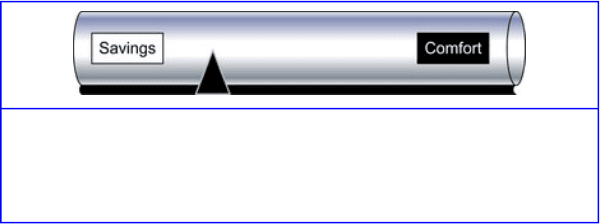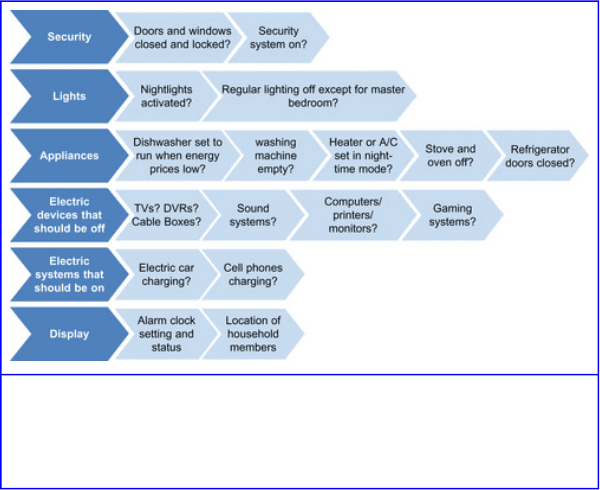Sioshansi F.P. Smart Grid: Integrating Renewable, Distributed & Efficient Energy
Подождите немного. Документ загружается.

to become even more attractive for consumers and vendors
offering the suite of services.
Home Automation Rides the Smart Grid Wave
For a home automation system to function there needs to be a
network for communication among devices and a centralized
management application, or controller. Network controllers
have certain requirements:
• Always be on,
• Stay at the home,
• Be connected to the Internet or an alternative
communications pathway.
The controller needs to be in a device that is always on so the
controller is always available to perform its home
management tasks. There are various devices in the home that
could be left on 24/7, such as a desktop computer and routers.
However, desktop computers use too much energy to be left
on 24/7 compared to a router, which is very rarely turned off
intentionally. Another option might be a laptop computer but
laptops on the move are not always connected to the Internet,
as for example, during air travel. And, for those left at home,
having the controller somewhere else may prove to be
problematic.
Looking forward, home computers as we know them today
may be abandoned altogether in the not too distant future (see
Box 1), except perhaps for computers used by gaming
enthusiasts—these would not work well as a controller due to
their high energy use.
17
Some vendors have produced
dedicated devices, such as in-home display devices, but with
the penetration of smart phones and tablets occurring at such
751

a rapid pace, dedicated devices are already looking
anachronistic [11].
17
Gaming computers often include two hard drives, very fast CPU, and a
large power supply. This author measured the demand of a gaming
computer at 1 kW.
Tablets and Smartphones Slow Laptop Sales
Growth [12]
“Tablet computers and smart phones are slowing the
growth of laptop sales, according to Gartner (IT)
released Thursday [3/3/2011]. The research firm
projects that laptop sales will grow less than
previously expected this year and next year because
of the surging popularity of alternative
mobile-computing devices….
“We now believe that consumers are not only likely
to forgo additional mobile PC buys, but are also
likely to extend the lifetimes of the mobiles PCs they
retain as they adopt media tablets and other mobile
PC alternatives as their primary mobile device,”
Gartner research director George Shiffler said in a
statement.
As smart phones and tablets, such as Apple's (AAPL)
iPad, boost their computing power, more and more of
these devices are becoming capable of performing the
same tasks as laptops. Additionally, laptops are losing
752

their fashion-forward cachet compared to iPads and
smart phones, Gartner says.”
Almost every home with an Internet connection has a router,
and routers are not expensive to replace—this would be
within the budget of most households that already own a
router. If the controller application were added to the router, it
is not expected to significantly raise the cost of the router,
especially if is planned that consumers will interface to the
controller through other devices. And, of course, the router is
connected to the Internet.
The controller needs to be connected to the Internet to access
information used by applications that are part of the home
automation system. The types of information that may be
provided over the Internet include energy prices, comparisons
to other “similar” households, weather forecasts, updates to
the home automation system, updates to security for home
automation systems, updates to applications on smart devices
included in the home automation network, and new
applications available to download.
In addition, the home automation network may provide
information to utilities or other parties (with the permission of
the consumer). For example, a home automation system may
order new filters to be delivered to the home on a regular
basis during the cooling season, or send information to the
manufacturer of a smart appliance when the smart appliance
detects a malfunction. In either of these cases, the consumer
would need to approve sharing the information with an
outside party.
753
Consumers already take advantage of similar services with
regular deliveries of medications, dairy products, books,
movies, or other items that are needed or enjoyed on a regular
basis. People like the convenience of having items delivered,
and in the case of air conditioning filters, the delivery may
serve as a reminder that it's time to change the filter.
One manufacturer of smart appliances has already set up a
means to extract information from its washing machines if the
appliance detects something wrong. After calling a tech
center, the consumer pushes a button, and the washer sends
data from the appliance directly to the tech team over the
phone. A home automation application might send this same
information over the Internet to the tech center (again with the
consumer's permission); using the information provided, the
tech center may be able to diagnose the problem remotely
and, through email or text messages exchanges with the
consumer, come up with a plan. In some cases, the consumer
may simply be provided with instructions for cleaning hoses
or filters, or in others, a part may be mailed to the consumer
with instructions for installation. Or a service call could be
scheduled. In many cases, the applications that might be
included in a home automation system have seeds in services
already provided or in routines that consumers typically go
through on a daily basis.
A weather forecast might be used for managing energy use
for cooling or heating to pre-cool or pre-heat when energy
prices are lower than during the peak times for heating or
cooling. Or, it may allow for cooling to be avoided if a
thunderstorm is predicted to move through the area and the
high temperatures initially forecast may not occur. A
consumer should have the option to specify different criteria
754

to use for planning when heating and cooling will occur based
on their preferences. It could be as simple as moving a slide
on a smart phone as shown in Figure 15.6, with the focus on
comfort or spending. Or more complex options might be
provided for the consumer to select what areas of the home
always need to be really comfortable and other areas where it
would be OK for the temperature to drift a bit higher or lower
at certain times of the day.
Figure 15.6
Comfort versus spending slide bar.
Source: CSC, April 2011, with inspiration from PNNL Labs and others
While keeping homes comfortable is likely to continue as a
focus of home automation systems, entertainment
applications will need to adapt to the increased options for
watching TV or movies, listening to music or books, and
reading. It used to be that having music in any room, home
theater, and watching a movie on any TV in the house, as
opposed to the nearest TV to the DVD player, were large
parts of home automation. As consumers have shifted to
listening to music on MP3 players, iPods™, and smart
phones, providing music to every room via a stereo will be a
lower priority for consumers. In addition, now that consumers
can stream movies or TV episodes to personal devices or
large-screen TVs, home automation will likely include
applications to make it more convenient and easier for
755
consumers to avail themselves of new options for watching
TV and movies.
As consumers bring smart appliances and devices into their
homes, each device should be preset to include applications
that reduce peak energy use and support the energy-efficient
use of the product. Each vendor can differentiate itself by
providing innovative ways for its particular product to reduce
energy use when prices are high and support energy
efficiency, as well as provide other features to take advantage
of home automation. Standards come into play here because
the home automation controller, housed in the router, must be
able to communicate with smart appliances and other devices
manufactured by any vendor. In order for the smart grid
vision, and indeed the vision of home automation, to catch the
fancy of consumers and become the next iPad-like item,
consumers can't be restricted to buying only products from
GE or Samsung.
When consumers bring a new smart device into their home,
the home automation system should “find” the new smart
device and ask the consumers if they would like to add it to
their home automation network. If they say “yes,” then the
controller and the new smart device would exchange
information so that the controller now knows what type of
smart device it is—a dishwasher as opposed to a TV, for
example—what applications it supports, and what
information the smart device requires to support its
applications. For example, a smart refrigerator may be able to
reduce energy use during a demand response event by
stopping defrosting activity, and allowing the temperatures
inside the refrigerator and freezer to drift upwards, but still
remain within safe operating temperatures. Perhaps ice
756
making could also be suspended. Thus the smart refrigerator
could support demand response events as long as it was
notified with the triggering energy price or demand response
event. Manufacturers of smart refrigerators would want to
select applications carefully that would support reduced
energy use but, at the same time, not interfere with the main
function of the appliance. In this case, this would most likely
mean allowing the light to come on when the door is opened.
To support consumer control over their smart devices, if the
consumer noticed that ice production had ceased and objected
to it, the consumer could use his or her smart phone to change
this setting for the smart refrigerator during demand response
events.
The example described for a smart refrigerator incorporates
two important features of home automation: first, the demand
response setting is the default setting, and second, consumers
can change the default setting if they wish. If the home
automation controller can also use information on the location
of individual household members, it is also possible to
customize the smart refrigerator's response to a demand
response event based on which household member is home at
the time. Some home automation systems already feature
using the location of individual household members for
energy and security applications. Some household members
may frequently use ice and others may not, for example.
A smart washing machine and dryer may take a different
approach to responding to demand response events than for
managing the dishwasher. Consumers may accept the
dishwasher running anytime between 11 PM and 6 AM, as long
as the dishes are clean when they get up. Laundry is different
because it's usually a two-step process, washing and then
757
drying, and more often than not, more than one load needs to
be accomplished in one day. The default response for a smart
washer and dryer may be simply to alert customers that if
they start the load now, finishing the load may extend into the
demand response period. Thus, the smart washing machine
and dryer may need to know of a demand response event
before it happens, if this information is available.
However, there are electric grid emergencies that only require
a short period of energy reduction, perhaps seconds or
minutes, before the emergency is resolved. The Department
of Energy's Pacific Northwest National Laboratory, managed
by Batelle, developed a technology to detect a disturbance on
the electric grid by monitoring the frequency and voltage of
the system.
18
If this technology were included in smart
appliances, such as a washer and dryer, then for a few
seconds or minutes, the washer and dryer could pause their
operations, providing a real benefit to grid operators while not
significantly affecting when washing and drying cycles would
be completed. During the short response period to the
disturbance, a dryer could shut off its electric heating element
and tumble the clothes once a minute to prevent wrinkles
developing and the washer could just rest.
18
Grid Friendly™ appliance controller licensed for market development
[13].
A smart appliance with technology to detect grid disturbances
could alert the controller for the home automation system of
the grid disturbance, and perhaps other smart devices could
also respond to the grid disturbance, if they didn't have the
technology embedded. For example, perhaps lights could be
758
dimmed, a defrost cycle stopped temporarily, or battery
charging paused for a few minutes.
The grid disturbance and demand response are scenarios of
interest to grid operators, generators, energy suppliers,
utilities, and other market participants. Both offer potential
financial revenue streams. In contrast, consumers are going to
be interested in scenarios that address their needs. These
scenarios tend to involve more than one smart device and may
require more input from consumers to implement, depending
on how “smart” the smart devices are. For example, is a
sensor, on a door going to be automatically identified as a
“door” sensor and will a smart light be automatically
identified as being located in the living room as opposed to a
bedroom? The goal would be for consumers to provide
information about their home in an intuitive manner, which
does not require programming skills, which many consumers
do not have. Once the controller knows what each device is
and where it is located, then the home automation system can
offer default versions of applications for consumers to review
and possibly tweak to fit their needs.
Consider the “Going to Bed” app discussed earlier in the
section “Consumer Adoption.” Imagine a household with two
children in elementary school, Ted and Lucy, each with their
own bedroom, and the parents are using the “Going to Bed”
app immediately prior to retiring for the night. Using an iPad,
one of the parents activates the app similar to using any other
app on their iPad. The app immediately sends out a series of
queries to the smart systems/appliances/devices joined to their
home area network, as shown in Figure 15.7.
759

Figure 15.7
Queries for “Going to Bed” app.
Source: CSC, May 2011
The app would send a signal to the home management system
housed in the household router via Wi-Fi to run the “Going to
Bed” app. The router would then send signals to each system
or appliance through the appropriate protocol such as ZigBee
2.0 or Wi-Fi or another protocol, asking for status
information. For example, it would send a request appropriate
for the washing machine to try to ascertain if there are any
wet clothes left in the washing machine. It will vary from
machine to machine how sophisticated and accurate this
information might be. One machine may only be able to
report whether a cycle is running or not, while another may be
able to report on the weight of the clothes in the drum and, if
a cycle is running, the time remaining in the cycle. The home
management system will use whatever information is returned
to provide useful information to the person using the app.
760
